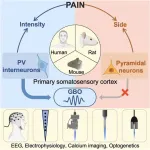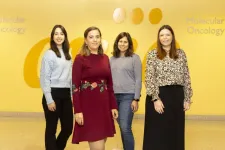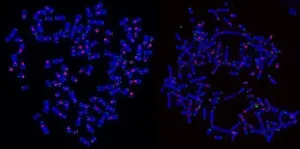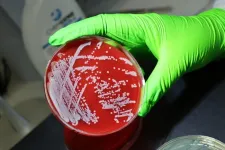(Press-News.org) “Microplastic particles are currently found almost everywhere – in water, food, fish, and even breast milk,” says Artūras Torkelis, a PhD student at Kaunas University of Technology (KTU). He emphasises that proper waste management is essential for reducing these risks.
The use of plastic in Europe has skyrocketed over the past decade. Recent statistics reveal that in 2021, each person in the European Union (EU) generated an average of 36 kg of plastic packaging waste. Of the more than 16 million tonnes of plastic packaging generated that year, only 6.5 million tonnes were recycled. Plastic recycling remains a serious problem. Inadequate recycling not only increases the amount of waste left in landfills, incineration plants and nature but also contributes to the formation of microplastics, which threaten both ecosystems and human health.
According to Torkelis, to improve the situation, the waste management process cannot be addressed from only one side. It is a multidimensional problem, and therefore, the approach to it must be broad and systemic.
“Focusing solely on improving recycling technologies or finding new methods without considering economic, environment and legal aspects would be a mistake. This approach won’t just fail to solve the problem, it could also lead to shortfalls when considering other aspects,” says Torkelis.
To better understand how external factors influence plastic packaging recycling, KTU researchers conducted a macro-environmental analysis that examined six key areas: political, economical, social, technological, ecological, and legal factors.
Challenge #1: Outdated waste management regulations
Political and legal factors include a range of legislation and policies to regulate the management of plastic packaging waste. They help to control producers, waste managers, and recyclers but are often insufficient to ensure smooth and efficient waste management.
For example, for a long time, the EU’s plastic packaging waste system was governed by the Packaging and Packaging Waste Directive, adopted 30 years ago, which left it up to the countries to decide how to meet the targets set. “As a result, these goals were often difficult to meet, as countries implemented them in different ways,” explains Torkelis, a PhD student at KTU Institute of Environmental Engineering.
It was not until 2024 that a new regulation was adopted, which will soon come into force and will be equally applicable to all countries. This will ensure clearer and more efficient recycling of plastic packaging.
Challenge #2: Lower quality recycled plastics
Discussing economic aspects, Torkelis highlights that current recycling technologies often fail to produce high-quality recycled plastics in a cost-effective manner. Consequently, recycled plastics are sold at prices that are 2-3 times lower than virgin plastics in global markets.
Additionally, oversupply from China, other Asian countries, and North America further reduces the competitiveness of recycled plastics. Because virgin plastics are often more adaptable and cost-effective, they remain the preferred choice for manufacturers.
Challenge #3: Public attitudes towards recycling vary
Even though primary sorting, where waste is immediately separated by type in the home environment, is more efficient than secondary sorting, where mixed waste is sorted only at sorting centres, motivating people to do so remains a challenge.
A common myth is that sorted waste ultimately ends up in landfills or is incinerated, undermining public motivation to recycle. “That’s why educational initiatives that show the journey of waste from collection to recycling are so important,” says Torkelis.
In Lithuania, the KTU expert highlights the example of Alytus, where successful prevention measures have helped to increase the involvement of the population and ensure better waste sorting. However, attitudes and behaviour vary in other Lithuanian cities.
“In Kaunas, for instance, it is noticeable that waste collected from private houses is usually cleaner than waste from public containers in apartment blocks,” he says. This shows that individual responsibility and social norms influence the quality of sorting.
Challenge #4: Recycling composite packaging is challenging
According to Torkelis, although the technologies of plastic packaging waste recycling are sufficiently developed and continuously improved, recycling composite packaging still presents challenges.
KTU specialist says that current solutions are often inefficient – not just technologically, but also economically and environmentally, which is why more and more attention is being paid to eco-design: “The focus is not only on whether packaging can be recycled but also on its initial design, ensuring it is easy to recycle or reuse”.
He believes that the use of combined packaging should be limited to cases where it is essential, such as pharmaceuticals, while it should be discouraged in other areas where it is often chosen for aesthetic reasons.
Challenge #5: Plastic waste is still leaking into the natural environment
Addressing environmental concerns, Torkelis mentions microplastics and the damage they cause to the environment and living organisms. Microplastics in the environment are the result of improperly managed plastic waste, so it is essential to ensure that there is no uncontrolled release of waste into the natural environment throughout the plastic packaging cycle.
Although reducing plastic waste remains a primary goal, recycling is essential to manage the plastic already in circulation. The EU’s target of recycling 50 per cent of plastics by 2025 has not been achieved. Now the goal is to recycle 55 per cent by 2030.
The article The Factors Influencing the Recycling of Plastic and Composite Packaging Waste was published in Sustainability Journal, and can be accessed here.
END
From microplastics to macro-impact: KTU expert explains plastic recycling challenges
The use of plastic in Europe has skyrocketed over the past decade. Recent statistics reveal that in 2021, each person in the European Union (EU) generated an average of 36 kg of plastic packaging waste
2025-01-13
ELSE PRESS RELEASES FROM THIS DATE:
How does the brain encode pain? Scientists uncover neuronal mechanisms of pain intensity encoding
2025-01-13
A research team led by Prof. HU Li at the Institute of Psychology of the Chinese Academy of Sciences, has revealed that parvalbumin (PV) interneurons in the primary somatosensory cortex (S1) preferentially encode pain intensity and drive nociceptive-evoked gamma oscillations (GBOs).
Published online in Neuron on January 13, the study fills a longstanding gap in understanding the origins of nociceptive-evoked GBOs and their selective relationship with pain processing across different species.
The findings suggest the potential for using these oscillations as a promising target for therapeutic interventions.
Pain is a ...
Study finds opioid pain medications very infrequently prescribed to NFL players
2025-01-13
INDIANAPOLIS – Due to the physical contact nature of their occupation, the elite athletes of the National Football League (NFL) often experience pain. However, an analysis of 2021 and 2022 data from the National Football League Prescription Drug Monitoring Program shows that team members in those two years were even less likely than both the general U.S. population and males of similar age living in the U.S., to have a prescription for an opioid pain medication.
The study found that less than 3 percent of pain medications prescribed to the athletes who played in one or both of the two seasons were for opioids. Slightly more than 86 percent of the ...
Wrong place, wrong time: Why Zika virus hijacks a protein needed for brain growth
2025-01-13
The mosquito-borne Zika virus is known for causing microcephaly, a birth defect in which abnormal brain development results in a smaller-than-expected head. A new study published Jan. 13 in mBio shows that the Zika virus hijacks a host protein called ANKLE2, which happens to be important for brain development, to assist its own reproduction. Because Zika, unlike most related viruses, can cross the placenta, this can have disastrous consequences in pregnancy.
“It’s a case of Zika being in the wrong place at the wrong time,” said Priya Shah, associate professor in the departments of Microbiology and Molecular ...
The new age of infrastructure maintenance using data from space
2025-01-13
The concentration of the population in cities is accelerating, and difficulties in maintaining various infrastructures are arising due to extreme weather. Extensive infrastructures like waste landfill facilities face significant challenges due to the difficulty for managers to stay on-site or access them. These maintenance issues are resulting in various problems, including environmental pollution.
To solve these issues, Korea Institute of Civil Engineering and Building Technology (KICT, President Sun Kyu, Park) has developed a cost-effective and high-efficiency maintenance technology using satellite ...
CNIO and CNIC research identifies a key protein for ‘burning’ fat
2025-01-13
This work reveals a new mechanism by which brown fat is converted into heat, and which protects from pathologies associated with obesity.
The MCJ protein is key to the fat burning mechanism now identified, making it a promising target for treating obesity, according to the authors in Nature Communications.
The research is led by Guadalupe Sabio, from Spain’s National Cancer Research Centre (CNIO), and Cintia Folgueira, from both CNIO and the National Centre for Cardiovascular Research (CNIC).
Obesity, which affects 650 ...
‘True food’ research database offers rankings for 50,000 processed foods
2025-01-13
‘True Food’ Research Database Offers Rankings for 50,000 Processed Foods
The database, developed by researchers at Mass General Brigham and made available to the public, sheds light on the availability of processed foods at different grocery stores, highlighting the need for more understanding and regulation of the foods offered
A new study by investigators from Mass General Brigham provides information to empower consumers and policymakers about the degree of processing of the foods available at three large grocery retailers. Using an algorithm, the researchers analyzed ...
Mystery solved: how tumor cells die after radiotherapy
2025-01-13
Scientists at Children’s Medical Research Institute (CMRI) have solved a big mystery in cancer research – why cells die in different ways following radiotherapy. This surprising finding opens up new opportunities to improve treatment and increase cure rates.
The findings were published in Nature Cell Biology by first author Dr Radoslaw Szmyd of CMRI’s Genome Integrity Unit, which is led by Professor Tony Cesare.
Radiation therapy (also called radiotherapy) is a critically important type of cancer treatment. Scientists have struggled for decades to understand why radiation therapy kills cells from the ...
Bacterial survival genes uncovered using evolutionary map
2025-01-13
The most detailed study to date on the mechanisms by which a common type of bacterium, Staphylococcus aureus, adapts to living on the human body could help improve the prevention, diagnosis, and treatment of certain infections.
The study, from the Wellcome Sanger Institute, the University of Cambridge, the Institute of Biomedicine of Valencia (IBV) at the Spanish National Research Council (CSIC) and their collaborators, involved using the genomes of thousands of S. aureus isolates cultured from the human nose and on the skin to investigate which genes are important for the bacteria to adapt and persist.
Published today (13 January) in Nature Communications, ...
Sodium-ion batteries need breakthroughs to compete
2025-01-13
Legions of battery engineers and their supporters have sought for years to build batteries cheaper than the dominant lithium-ion technology, hoping to capture some of lithium-ion’s $50 billion-a-year and growing market. The latest darling contender among researchers, startups, and venture capitalists – sodium-ion batteries – has received much attention after COVID-induced mineral supply chain challenges sent lithium prices on a wild ride. Still, achieving a low-cost contender may be several years away for sodium-ion batteries and will require a set of technology advances and favorable ...
Tumor DNA in the blood can predict lung cancer outcome
2025-01-13
Scientists from the Francis Crick Institute, UCL, UCLH and Personalis have found that a test to detect circulating tumour DNA can predict lung cancer outcome in a Cancer Research UK-funded study.
Circulating tumour DNA (ctDNA) is fragments of DNA released into the blood by tumours. It’s known to be important for disease prognosis but can be difficult to measure precisely.
In research published today in Nature Medicine, Crick and UCL scientists worked with Personalis to test a platform called NeXT Personal, which can detect very small amounts – 1 part per million – ...
LAST 30 PRESS RELEASES:
Scientists use ultrasound to soften and treat cancer tumors without damaging healthy tissue
Community swimming program for Black youth boosts skills, sense of belonging, study finds
Specific depressive symptoms in midlife linked to increased dementia risk
An ‘illuminating’ design sheds light on cholesterol
Who is more likely to get long COVID?
Study showcases resilience and rapid growth of “living rocks”
Naval Research Lab diver earns Office of Naval Research 2025 Sailor of the Year
New Mayo-led study establishes practical definition for rapidly progressive dementia
Fossil fuel industry’s “climate false solutions” reinforce its power and aggravate environmental injustice
Researchers reveal bias in a widely used measure of algorithm performance
Alcohol causes cancer. A study from IOCB Prague confirms damage to DNA and shows how cells defend against it
Hidden viruses in wastewater treatment may shape public health risks, study finds
Unlock the power of nature: how biomass can transform climate mitigation
Biochar reshapes hidden soil microbes that capture carbon dioxide in farmland
Reducing saturated fat intake shows mortality benefit, but only in high-risk individuals
Manta rays create mobile ecosystems, study finds
Study: Mixed results in using lipoic acid to treat progressive multiple sclerosis
Norbert Holtkamp appointed director of Fermi National Accelerator Laboratory
New agentic AI platform accelerates advanced optics design
Biologists discover neurons use physical signals — not electricity — to stabilize communication
Researchers discover that a hormone can access the brain by hitchhiking
University of Oklahoma researcher awarded funding to pursue AI-powered material design
Exploring how the visual system recovers following injury
Support for parents with infants at pediatric check-ups leads to better reading and math skills in elementary school
Kids’ behavioral health is a growing share of family health costs
Day & night: Cancer disrupts the brain’s natural rhythm
COVID-19 vaccination significantly reduces risk to pregnant women and baby
The role of vaccination in maternal and perinatal outcomes associated with COVID-19 in pregnancy
Mayo Clinic smartwatch system helps parents shorten and defuse children's severe tantrums early
Behavioral health spending spikes to 40% of all children’s health expenditures, nearly doubling in a decade
[Press-News.org] From microplastics to macro-impact: KTU expert explains plastic recycling challengesThe use of plastic in Europe has skyrocketed over the past decade. Recent statistics reveal that in 2021, each person in the European Union (EU) generated an average of 36 kg of plastic packaging waste






